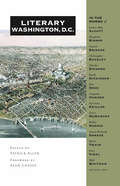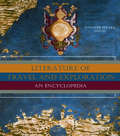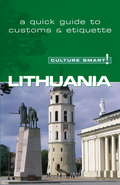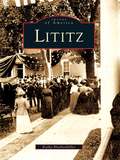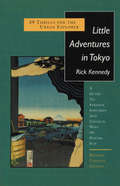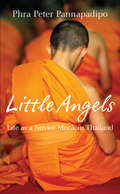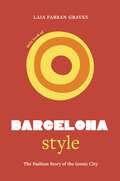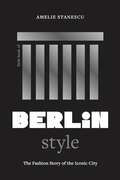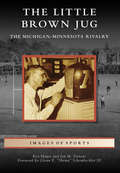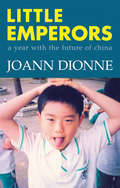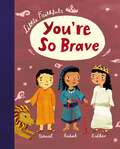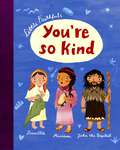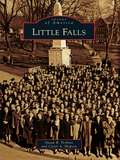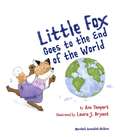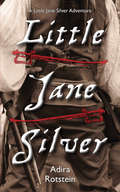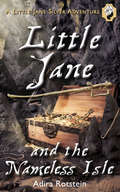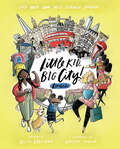- Table View
- List View
Literary Washington, D.C.
by Alan Cheuse Patrick AllenThe public face of Washington-the gridiron of L'Enfant's avenues, the buttoned-down demeanor Sloan Wilson's archetypal "Man in the Grey Flannel Suit," the monumental buildings of the Triangle-rarely gives up the secrets of this city's rich life. But, beneath the surface there are countless stories to be told. From the early swamp days to the Civil War, the "gilded age" to the New Deal and McCarthy eras, as the center of world power to its underlying multicultural social fabric, Washington is a writer's town.While this is surprising to some, it is not news to the close observer. Alan Cheuse, in his foreword to Literary Washington, D.C. comments: "Part of this peculiar city's sense of place is that it serves as a capital for people who have no permanent sense of place. . . . War has brought us here, peace has brought us here, love has kept us here, and love or loss of love will give some of us reason to leave again. Which makes Washington, D.C. exactly like most other places in the rest of the country and the rest of the world-only more so."In fact, D.C. has been a magnet for great writers for centuries. Including novelists, poets, journalists, essayists, and politicians and patriots, finally, in Literary Washington D.C., the story of the capital of world power is finally told.
Literary Washington, D.C.
by Alan Cheuse Patrick AllenThe public face of Washington-the gridiron of L'Enfant's avenues, the buttoned-down demeanor Sloan Wilson's archetypal "Man in the Grey Flannel Suit," the monumental buildings of the Triangle-rarely gives up the secrets of this city's rich life. But, beneath the surface there are countless stories to be told. From the early swamp days to the Civil War, the "gilded age" to the New Deal and McCarthy eras, as the center of world power to its underlying multicultural social fabric, Washington is a writer's town.While this is surprising to some, it is not news to the close observer. Alan Cheuse, in his foreword to Literary Washington, D.C. comments: "Part of this peculiar city's sense of place is that it serves as a capital for people who have no permanent sense of place. . . . War has brought us here, peace has brought us here, love has kept us here, and love or loss of love will give some of us reason to leave again. Which makes Washington, D.C. exactly like most other places in the rest of the country and the rest of the world-only more so."In fact, D.C. has been a magnet for great writers for centuries. Including novelists, poets, journalists, essayists, and politicians and patriots, finally, in Literary Washington D.C., the story of the capital of world power is finally told.
Literature of Travel and Exploration: An Encyclopedia
by Jennifer SpeakeContaining more than 600 entries, this valuable resource presents all aspects of travel writing. There are entries on places and routes (Afghanistan, Black Sea, Egypt, Gobi Desert, Hawaii, Himalayas, Italy, Northwest Passage, Samarkand, Silk Route, Timbuktu), writers (Isabella Bird, Ibn Battuta, Bruce Chatwin, Gustave Flaubert, Mary Kingsley, Walter Ralegh, Wilfrid Thesiger), methods of transport and types of journey (balloon, camel, grand tour, hunting and big game expeditions, pilgrimage, space travel and exploration), genres (buccaneer narratives, guidebooks, New World chronicles, postcards), companies and societies (East India Company, Royal Geographical Society, Society of Dilettanti), and issues and themes (censorship, exile, orientalism, and tourism).For a full list of entries and contributors, a generous selection of sample entries, and more, visit the Literature of Travel and Exploration: An Encyclopedia website.
Lithuania - Culture Smart!
by Lara BelonogoffCulture Smart! provides essential information on attitudes, beliefs and behavior in different countries, ensuring that you arrive at your destination aware of basic manners, common courtesies, and sensitive issues. These concise guides tell you what to expect, how to behave, and how to establish a rapport with your hosts. This inside knowledge will enable you to steer clear of embarrassing gaffes and mistakes, feel confident in unfamiliar situations, and develop trust, friendships, and successful business relationships.Culture Smart! offers illuminating insights into the culture and society of a particular country. It will help you to turn your visit-whether on business or for pleasure-into a memorable and enriching experience. Contents include* customs, values, and traditions* historical, religious, and political background* life at home* leisure, social, and cultural life* eating and drinking* dos, don'ts, and taboos* business practices* communication, spoken and unspoken"Culture Smart has come to the rescue of hapless travellers." Sunday Times Travel"... the perfect introduction to the weird, wonderful and downright odd quirks and customs of various countries." Global Travel"...full of fascinating-as well as common-sense-tips to help you avoid embarrassing faux pas." Observer"...as useful as they are entertaining." Easyjet Magazine"...offer glimpses into the psyche of a faraway world." New York Times
Lititz
by Kathy BlankenbillerLititz may be just a speck on the map, but its historical impact is a match for any of the nation's biggest cities. Shaped by history, today Lititz sparkles as the village jewel of Lancaster County. Set against the breathtaking beauty of the surrounding countryside, this little town offers a thriving downtown, slow-paced atmosphere, and abundant recreational areas and cultural events. Lititz is the proud home of Julius Sturgis Pretzel Bakery, the nation's oldest pretzel bakery; Linden Hall, the oldest girls' boarding school in the United States; and the oldest continuous celebration of the Fourth of July. The vintage photographs in Lititz present a rare insider's view of a town of historical firsts in America, and they show why visitors always leave Lititz with the feeling of nostalgia for the hometown of their childhood.
Little Adventures in Tokyo
by Rick KennedyFrom the old traditions to the trendy and bizarre, here is a discovery guide to the singular delights of Tokyo and a whole new way of having fun in Japan. Wander the streets of the Old City, learn the secrets of pachinko, discover hidden cafes and jazz bars, meditate in a Zen temple. Cross indexed by location and duration.
Little Angels: The Real Life Stories of Thai Novice Monks
by Phra Peter PannapadipoThe real-life stories of the novice monks in Little Angels reflect the lives of many youths in rural Thailand who are trapped in the vicious cycle of poverty, broken homes, illiteracy and drug abuse. When all else fails, Buddhism becomes their last resort: providing them with physical shelter and spiritual refuge. It heals their childhood traumas and gives them a moral framework for living and a better outlook on life. Each individual story, heartrending as it may be, subtly shows what Phra Peter sees and hopes to show to others: the 'human face' of Thai Buddhism.
Little Book of Barcelona Style: The fashion story of the iconic city (Fashion Destinations)
by Laia Farran GravesSun, sea, art, architecture and a love of food are the cornerstones of Barcelona culture - and the city's eclectic but smart style scene reflects these passions. From the bars to the beach, Little Book of Barcelona Style explores the creative foundations and creative icons who defined and are influenced by this city, from architects and artists such as Gaudí and Dalí to contemporary street style icons such as Blanca Miro and contemporary brands that have gone global, like fashion world favourite Paloma Wool. Through 100 stunning images and expert text by a fashion writer, discover the style staples of a fashion capital whose designers and style icons aren't afraid to innovate.
Little Book of Barcelona Style: The fashion story of the iconic city (Fashion Destinations)
by Laia Farran GravesSun, sea, art, architecture and a love of food are the cornerstones of Barcelona culture - and the city's eclectic but smart style scene reflects these passions. From the bars to the beach, Little Book of Barcelona Style explores the creative foundations and creative icons who defined and are influenced by this city, from architects and artists such as Gaudí and Dalí to contemporary street style icons such as Blanca Miro and contemporary brands that have gone global, like fashion world favourite Paloma Wool. Through 100 stunning images and expert text by a fashion writer, discover the style staples of a fashion capital whose designers and style icons aren't afraid to innovate.
Little Book of Berlin Style: The fashion story of the iconic city (Fashion Destinations)
by Amelie StanescuWith an international population bringing culture from all over the world, a reputation for cool minimal style (read: black), and a party scene where what you wear is everything, Berlin has a reputation as one of the most stylish cities in the world.From the turbulence of the early twentieth century to today's status as a beacon for artists, writers and hedonists, Little Book of Berlin Style is your fully illustrated guide to Europe's edgiest city. From street style to the catwalk, and from the club to the atelier, over 100 images depict the buzzing fashion scene of this cult capital of contemporary fashion.
Little Book of Berlin Style: The fashion story of the iconic city (Fashion Destinations)
by Amelie StanescuWith an international population bringing culture from all over the world, a reputation for cool minimal style (read: black), and a party scene where what you wear is everything, Berlin has a reputation as one of the most stylish cities in the world.From the turbulence of the early twentieth century to today's status as a beacon for artists, writers and hedonists, Little Book of Berlin Style is your fully illustrated guide to Europe's edgiest city. From street style to the catwalk, and from the club to the atelier, over 100 images depict the buzzing fashion scene of this cult capital of contemporary fashion.
Little Book of Copenhagen Style: The fashion story of the iconic city (Fashion Destinations)
by Glenys JohnsonCopenhagen has a reputation for its incredible food and drink scene, inspiring galleries and, most importantly, the city's unmistakable style. Little Book of Copenhagen Style is packed with stunning imagery of notable fashion-forward residents, runway looks from the city's favourite labels and inspiring locations across the capital. Discover some of Copenhagen's finest fashion exports from key classics like Stine Goya and Ganni to streetwear staples like WoodWood and Soulland. Through 100 stunning images and expert text by a top fashion writer, Little Book of Copenhagen Style is your ultimate guide to this iconic fashion capital, from minimalism and monochrome to the weirder and wilder looks that further brighten this vibrant city.
Little Book of Copenhagen Style: The fashion story of the iconic city (Fashion Destinations)
by Glenys JohnsonCopenhagen has a reputation for its incredible food and drink scene, inspiring galleries and, most importantly, the city's unmistakable style. Little Book of Copenhagen Style is packed with stunning imagery of notable fashion-forward residents, runway looks from the city's favourite labels and inspiring locations across the capital. Discover some of Copenhagen's finest fashion exports from key classics like Stine Goya and Ganni to streetwear staples like WoodWood and Soulland. Through 100 stunning images and expert text by a top fashion writer, Little Book of Copenhagen Style is your ultimate guide to this iconic fashion capital, from minimalism and monochrome to the weirder and wilder looks that further brighten this vibrant city.
Little Book of Miami Style: The fashion story of the iconic city (Fashion Destinations)
by Ashley BrozicWith its art deco architecture, maximalist design and Cuban influence, Miami is a city of excess where chic and creative crowds flock. From swimwear to evening glamour, the Miami look is all about the heat - and being ready for everything from the beach to the club. Little Book of Miami Style explores the style icons, fashion history, design influences and street style of the Magic City - as well as how to get the Miami look.With over 100 stunning photographs accompanied by expert text from native Miamian Ashley Brozic, this is your beautifully illustrated guide to the fashion of this urban oasis.
Little Book of Miami Style: The fashion story of the iconic city (Fashion Destinations)
by Ashley BrozicWith its art deco architecture, maximalist design and Cuban influence, Miami is a city of excess where chic and creative crowds flock. From swimwear to evening glamour, the Miami look is all about the heat - and being ready for everything from the beach to the club. Little Book of Miami Style explores the style icons, fashion history, design influences and street style of the Magic City - as well as how to get the Miami look.With over 100 stunning photographs accompanied by expert text from native Miamian Ashley Brozic, this is your beautifully illustrated guide to the fashion of this urban oasis.
Little Brown Jug, The: The Michigan-Minnesota Football Rivalry (Images of Sports)
by Ken Magee Glenn E. Schembechler III Jon M. StevensWhen the Michigan Wolverines arrived in Minneapolis to battle the Minnesota Gophers in 1903, a simple 30¢, five-gallon Red Wing stoneware water jug began football's first rivalry trophy game. The "Little Brown Jug" has been the subject of conspiracy theories, theft, national championships, and most of all pride, with each game's victor prominently displaying the jug on its campus--until it is fought for again.
Little Emperors: A Year with the Future of China
by Joann DionneShort-listed for the 2009 City of Victoria Butler Book Prize Much has been made about how the New China has become an economic juggernaut in today’s world while civil liberties and basic freedoms remain constricted. We know where the aging leadership has taken and is taking China, but what about the very young? What are they like? When JoAnn Dionne arrived in Guangzho, she came prepared to live and teach elementary school in a Communist country. She expected to see soldiers in the streets, people in grey Mao suits, and lineups to buy toilet paper. Instead she found the world’s oldest country, throwing itself headlong into the future. She found traffic jams and 24/7 constructions, neon lights and smog, shopping malls and modern high-rises. And then she met the people who would live in that future – her students. Along with crisp insights into Chinese culture as seen through the eyes of a North American, Dionne provides a funny, often poignant glimpse of a nation undergoing rapid transformation.
Little Faithfuls: You're So Brave (Little Faithfuls)
by Carrie MarrsChildren will be inspired to be brave for God as they read this biography collection of Bible heroes who took action and did courageous things with God&’s help.Little Faithfuls is the first Christian series of &”Little&” biography collections for kids. Fans of the Little People, Big Dreams series, Who Was? series, and This Little Trailblazer and This Little Dreamer will love introducing their children to the best role models of all, straight out of Scripture.This beautiful picture book for 4 to 8-year-oldstells God&’s big story of bravery, from David fighting Goliath, Esther risking her life to save her people, and Mary believing the angel's announcement that she would be the mother of Jesusfeatures 12 godly men and women from your favorite Bible stories in the Old and New Testamentsreminds young readers what it means to be brave, why bravery is an exciting opportunity from God, and how they can be a brave part of God's story tooteaches that God helps people be brave and uses them for good in the worldempowers kids to take action and do the right thing even when it&’s scaryWith eye-catching art and age-appropriate biographical bonus facts, You're So Brave focuses on God's big story of bravery, culminating in Jesus' ultimate bravery on the cross. Children will learn that God's people were brave because they loved following God. As it points young readers back to the true source of their bravery, this inspiring picture book draws kids in to learn more about heroes of faith and to be brave right where they are.
Little Faithfuls: You're So Kind (Little Faithfuls)
by Carrie MarrsChildren will be inspired to be kind for God as they read this biography collection of Bible heroes who took action and showed kindness with God&’s help.Little Faithfuls is the first Christian series of &”Little&” biography collections for kids. Fans of the Little People, Big Dreams series, Who Was? series, and This Little Trailblazer and This Little Dreamer will love introducing their children to the best role models of all, straight out of Scripture.This beautiful picture book for 4 to 8-year-oldstells God&’s big story of kindness, from Joseph forgiving his brothers, Ruth choosing to go with Naomi to a new place, and Tabitha providing food and clothes for people in needfeatures 12 godly men and women from your favorite Bible stories in the Old and New Testamentsreminds young readers what it means to be kind, why kindness is an exciting opportunity from God, and how they can be a part of God's story by showing kindnessteaches that being kind shows others how much God loves themempowers kids to take action and do the right thing even when it&’s scaryWith eye-catching art and age-appropriate biographical bonus facts, You're So Kind focuses on God's big story of kindness, culminating in Jesus' ultimate kindness on the cross. Children will learn that God's people were kind because God first showed kindness to His people. As it points young readers back to the true source of kindness, this inspiring picture book draws kids in to learn more about heroes of faith and to be kind right where they are.
Little Falls
by Caryl A. Hopson Susan R. PerkinsNestled in a deep gorge along the Mohawk River, Little Falls first came into being as a village in 1811 and became Herkimer County's only city in 1895. With its close proximity to main routes of transportation via the Erie Canal system and railroad, as well as its access to waterpower from the Mohawk River, Little Falls became a manufacturing leader and Herkimer County's largest populated area. It was famous nationwide for its cheese market and innovations in dairy and cheese manufacturing equipment. It was the site of one of the worst train wrecks in the history of the New York Central Railroad, boasts the sixth-highest lift lock in the world, and is the hometown of a famous radio personality who started the televised dance show Twist-A-Rama in the 1960s.
Little Fox Goes to the End of the World
by Ann TompertOne day, while chasing a butterfly, Little Fox strayed farther and farther from her home. " Come back, Little Fox, " called her mother, "or you may get lost." But Little Fox was tired of playing near the mouth of her den. "Some day," she said, "I’m going to travel to the end of the world." "Oh," said her mother. "Is the end of the world very far?" As Little Fox’s imagination soars, she tells her mother how she will outsmart bears, tigers, elephants, monkeys, and even crocodiles. But finally, she’ll sail home, because "I shall miss you." The text, originally published in 1991, assumes new life with fresh illustrations by Laura J. Bryant.
Little Indiana: Small Town Destinations
by Jessica NunemakerWhere was James Dean's hometown? What do A. J. Foyt, Mario Andretti, and Al Unser have in common besides winning the Indianapolis 500? Where was the world's first theme park? Find these answers and more in Little Indiana: Small Town Destinations. Featuring towns of 15,000 or fewer inhabitants, Little Indiana explores where to eat, stay, play, and shop in over 90 small towns. After six years of traveling the state in search of amazing local experiences, blogger and TV host Jessica Nunemaker shares a treasure trove of what to expect in Hoosier small towns. Perfect for any length of excursion—day or weekend—the book is organized by region and town and provides travelers easy access to information found nowhere else. From wineries to antique shops, alpaca farms to chocolate stores, unique attractions are awaiting discovery. Full-color images showcase specialty stores, mouth-watering meals, and exciting attractions tucked off the beaten path. Proof that there's always something to do in a small town, this book is the perfect way to kick-start your next Indiana adventure!
Little Jane Silver: A Little Jane Silver Adventure
by Adira RotsteinMeet Little Jane Silver, the twelve year-old granddaughter of notorious Treasure Island pirate Long John Silver. Growing up on the Pieces of Eight, the pirate ship of her parents, Captains Bonnie Mary Bright and Long John Silver II, Little Jane is increasingly frustrated with being thrust below decks whenever any real pirating action takes place. Desperate to be taken seriously as a member of the crew, Little Jane vows to become a real pirate, but every attempt she makes to prove herself onboard seems to backfire. As the Pieces of Eight is pursued by a mysterious pirate hunter, Little Jane tries to alert the crew to a devious saboteur on the ship, but by the time someone pays attention, its too late. On her own for the first time, Little Jane must grow up fast and find the courage to undergo the most important test of her young life a quest to save her family.
Little Jane and the Nameless Isle: A Little Jane Silver Adventure
by Adira RotsteinLittle Jane encounters treachery and adventure on her voyage to the Nameless Isle in search of her parents’ buried treasure. Second book in the Little Jane Silver Adventure series. Only two people have ever survived a trip to the Nameless Isle: Long John Silver the Second and Bonnie Mary Bright, the parents of aspiring pirate Little Jane Silver. They thought the volcanic caves on the island would be great places to store their treasure, but they were mistaken.Pirate hunter Fetzcaro Madsea and his crew have taken Long John and Bonnie Mary prisoner and are now forcing the pirates to guide them across the island to the treasure. Hoping to use their secret knowledge of the island’s dangers to thin out their foes, Long John and Bonnie Mary take a deadly risk. Meanwhile, Little Jane rushes to intercept them by taking a secret route.Do Little Jane and her friends have what it takes to brave the terrors of the island? Will she reach her parents in time to save them from the vengeful Madsea? And what strange horror lies in wait for them all in the lair of the island’s peculiar orange birds?Hold fast to your courage and read on!
Little Kid, Big City!: London (Little Kid, Big City #2)
by Beth BeckmanIf you could have an adventure in London, where would you go? Curious kids will find plenty to see, learn, and explore in this fun and illustrated pick-your-own-path travel guide!Would you hop on the Tube to visit Buckingham Palace, find a tasty lunch on Brick Lane, or pass the time with Big Ben?Create your own itinerary, choose which places to visit at the end of every page, and follow along with an adventurous girl and her two moms as they explore London. • Visit iconic sites like Big Ben, the British Library, Westminster Abbey, and the Globe Theatre. • Sample British favorites such as fish and chips and Afternoon Tea. • Hop on and hop off a double decker bus, dart through the Tube, or float along the River Thames. • See the London skyline with visits to the London Eye, the Tower Bridge, and St. Paul&’s Cathedral. • Get to know the diversity of the city with visits to Chinatown and Brick Lane. Featuring playful illustrations, a diverse and lovable cast of characters, an invaluable resources section, and a fun foldout map, this book is an ingenious way for kids to take the lead while planning a vacation or learning about one of the largest cities in the world. Whether you&’re an armchair traveler or a real-life tourist, Little Kid, Big City! has everything you need to invent your own adventure! Next stop, Little Kid, Big City!: New York
